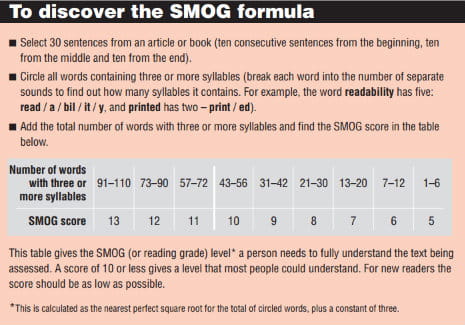by Nyomi Graef and Ross James.
We were involved in a translation project to provide training materials for health workers for use in radio programmes. Our task was to prepare the original English materials for translation by making them easier to read and understand.
The SMOG formula (see box) is a common method used to measure the readability of printed materials. It can be used to reduce the number of words with three or more syllables, as shorter words are easier to read.
We also found three very useful editing techniques. These were to simplify technical words, modify grammar and consider the socio-cultural context.
Simplify technical words Either replace jargon or difficult technical terms with similar, simpler words, or explain them fully, if readers need to use them.
Modify grammar Remove unnecessary verbs and keep the number of actions in a sentence to a minimum. For example:
Interviewers should be able to demonstrate friendliness, sincerity, and familiarity with the purpose and background of the study.
could be simplified to
Interviewers should be friendly, sincere, and familiar with the purpose and background of the study.
Change negatively-worded phrases to the positive and remove double negatives. Use the ‘active tense’ instead of the ‘passive tense’. For example:
Choose friendly and sincere interviewers.
Many nouns close together could be presented as a list. For example:
The components of interviewing are planning, preparation, forming and asking questions, introducing an interview…
becomes
The parts of interviewing are:
Plan
Prepare
Form and ask questions
Introduce an interview.
Socio-cultural context Keep in mind the purpose of simplifying the text and the target audience.
Our revised materials had to:
- keep the theory of health promotion and communication.
- use technical terms used by health professionals
- be easy to understand without being patronising
- be culturally neutral – replace terms that are distinctly Australian or British (replace ‘the patient is as fit as a fiddle’ with ‘the patient is really well’), or which may have different meanings in different cultural, ethnic and religious contexts.
We hope our experience will help both in preparing materials for translation and for newly literate people.
Nyomi Graef works at Curtin University of Technology, and Dr Ross James is director of Health Communication Resources. E-mail: [email protected]









